#Canine Distemper Virus
Explore tagged Tumblr posts
Text
Recognizing Early Signs of Canine Distemper in Dogs
Canine Distemper is a serious and often fatal disease that affects dogs worldwide. Caused by the Canine Distemper Virus (CDV), this highly contagious disease can spread rapidly among unvaccinated dogs, leading to severe health complications. Recognizing the early signs of Canine Distemper Disease is crucial for ensuring prompt veterinary care and improving the chances of recovery.

What is Canine Distemper?
Canine Distemper is a viral disease that affects a dog’s respiratory, gastrointestinal, and nervous systems. The virus is primarily spread through airborne exposure (e.g., sneezing or coughing) and direct contact with infected animals or contaminated objects. Puppies and unvaccinated dogs are especially vulnerable to the disease.
Early Signs of Canine Distemper
Early detection of Canine Distemper can make a significant difference in the outcome for your dog. Here are some of the initial signs to watch for:
Fever: One of the first signs of Canine Distemper is a sudden onset of fever. This initial fever may be mild and go unnoticed, but it can return with greater intensity. Monitoring your dog’s temperature regularly can help detect this early sign.
Eye Discharge: Clear or watery discharge from the eyes is another common early symptom. This discharge can quickly become thick, yellow, and crusty as the disease progresses. Your dog’s eyes may also appear red and swollen.
Nasal Discharge: Similar to the eye discharge, dogs with Canine Distemper may develop a runny nose. This nasal discharge may start as clear but can become thick and pus-like, indicating an infection.
Coughing and Sneezing: The Canine Distemper Virus often affects the respiratory system, leading to coughing, sneezing, and difficulty breathing. These symptoms can be mistaken for kennel cough or other respiratory infections, so it’s important to seek veterinary advice if they persist.
Lethargy: Dogs in the early stages of Canine Distemper often exhibit signs of lethargy and depression. If your dog seems unusually tired, uninterested in activities, or is sleeping more than usual, it could be an early indication of the disease.
Loss of Appetite: A decrease in appetite or refusal to eat is a common early symptom. Dogs with Canine Distemper may also experience weight loss due to their reduced food intake.
Vomiting and Diarrhea: Gastrointestinal symptoms such as vomiting and diarrhea can occur in the early stages. These symptoms can lead to dehydration, so it’s important to ensure your dog stays hydrated and seek veterinary care promptly.
Hardening of Paw Pads and Nose: In some cases, dogs with Canine Distemper develop a condition known as hyperkeratosis, which causes the paw pads and nose to harden and thicken. This is a more advanced sign but can occur early in the disease’s progression.
What to Do if You Suspect Canine Distemper
If you notice any of these early signs of Canine Distemper in your dog, it is crucial to seek veterinary care immediately. Early intervention can make a significant difference in the prognosis and treatment outcomes. Tri-County Animal Hospital offers comprehensive diagnostic and treatment services to manage Canine Distemper Disease effectively.
Diagnosing Canine Distemper
Veterinarians diagnose Canine Distemper through a combination of clinical signs, medical history, and laboratory tests. Blood tests, polymerase chain reaction (PCR) tests, and antibody tests are commonly used to confirm the presence of the Canine Distemper Virus. Prompt and accurate diagnosis is essential for initiating appropriate treatment and care.
Preventing Canine Distemper
The best way to protect your dog from Canine Distemper is through vaccination. Puppies should receive their first distemper vaccine at six to eight weeks of age, followed by booster shots every three to four weeks until they are 16 weeks old. Adult dogs should receive regular booster shots as recommended by their veterinarian. Tri-County Animal Hospital can provide guidance on an appropriate vaccination schedule for your dog.
Conclusion
Recognizing the early signs of Canine Distemper in dogs is vital for ensuring timely and effective treatment. If you notice any symptoms such as fever, eye or nasal discharge, coughing, lethargy, loss of appetite, vomiting, diarrhea, or hardening of the paw pads and nose, seek veterinary care immediately. Early diagnosis and intervention, along with preventive measures like vaccination, are key to protecting your dog from this serious disease. For expert care and advice on Canine Distemper, contact Tri-County Animal Hospital today to schedule an appointment.
#Canine Distemper#Canine Distemper Virus#Canine Distemper Disease#Early Signs of Canine Distemper#Symptoms of Canine Distemper#Dog Health#Pet Health#Tri-County Animal Hospital#Dog Fever#Dog Respiratory Symptoms#Dog Gastrointestinal Issues#Dog Eye Discharge#Dog Lethargy#Dog Neurological Symptoms#Canine Distemper Prevention#Canine Distemper Treatment#Dog Vaccination#Veterinary Care#Pet Care#Canine Distemper Diagnosis
0 notes
Text
My thoughts of the new Minecraft wolf variants!
With the recent announcement of the new wolf variants, I wanted to give my two bits about what real life animal each of the variants are based on! (I study animal ecology so I get excited when animals are depicted in anywhere)
The Pale Wolf, Black Wolf, Snowy Wolf, Ashen Wolf, and Woods Wolf
All of these wolf variants are based on the Grey Wolf (Canis lupus), whether it be the typical Plains Wolf (Canis lupus nubilus), or a different subspecies. The Grey Wolf is the most common wolf species found on the world, typically lives in packs of 4-9 members, and typically has 5 accepted subspecies in the science community - but in total has over 30 subspecies (determining subspecies can be tricky).
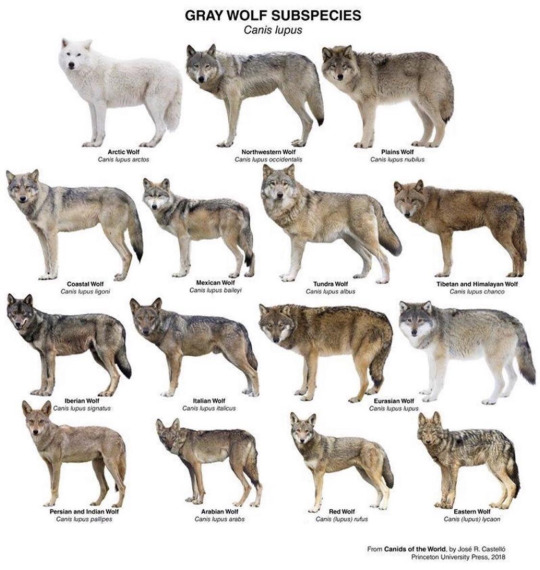
The Pale Wolf is specifically meant to represent a Plains Wolf, as this design has been representing the Grey Wolf in Minecraft for at least 12 years. The Taiga biome is one of the biomes where Grey Wolves can be found, making it a great place to find Pale Wolves in Minecraft.

The Black Wolf is not a subspecies, but rather a color variant of the Gray Wolf. The black coloring of their coats is not typically caused by melanism, but rather is a normal gene found in Grey Wolves. One of the causes of wolves having a black coat is due to the black gene being linked to higher immunity to canine distemper, meaning the black wolves that survive the virus are able to reproduce and pass on their black genes. Does this mean distemper exists in Minecraft? Probably not, but that's up to your interpretation.

The Snowy Wolf is based on the Arctic Wolf (Canis lupus arctos). Artic wolves' white coats help them blend into the snow to help them hunt prey, and to hide them from potential predators.
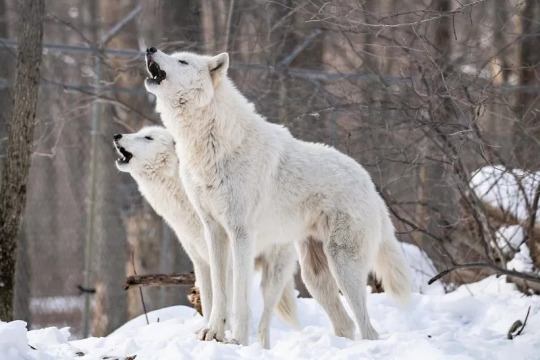
The Ashen Wolf is likely based on the Eurasian Wolf (Canis lupus lupus). The Eurasian wolf can have similar coloring to the plains wolf, but has also been found with greyer coloring along its back, tail, and upper legs and face, and with white on its cheeks, underbelly and lower legs.
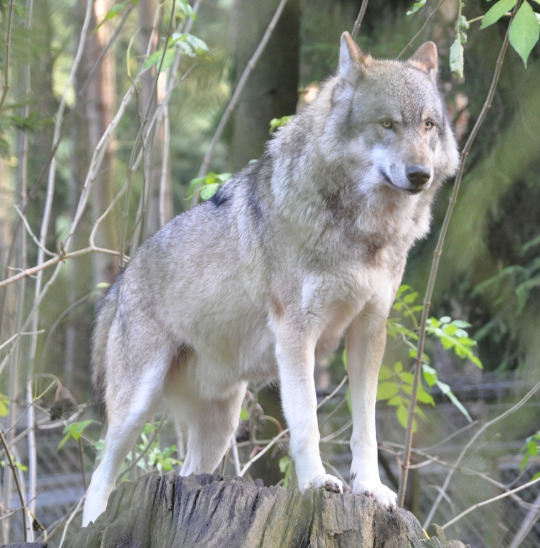
I think that the Woods Wolf is based on the Tibetan/Himalayan Wolf (Canis lupus chanco). It was a challenge to find what subspecies the woods wolf was based on because most wolves don't have the deep brown-orange coloring seen on the woods wolf, but the Tibetan/Himalayan wolf can often be seen with these colorings in the wild.
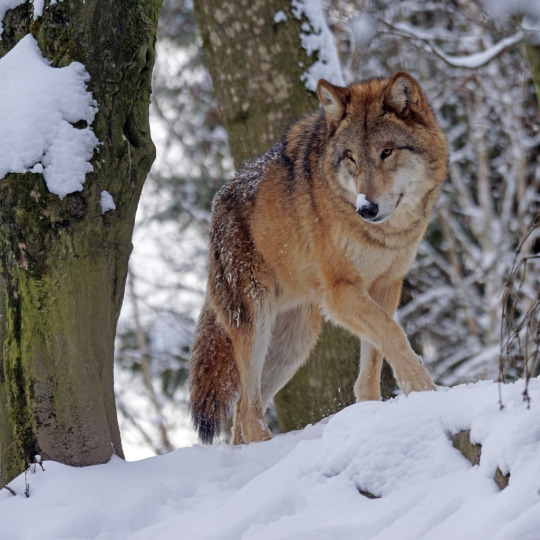
The Rusty Wolf
The Rusty Wolf is based on the Dhole (Cuon alpinus), also known as the Asiatic Wild Dog. Dholes have a rich tawny coat with a rich chocolatey tail. Unlike another popular red canine (the dingo), Dholes live in tropic forests, rainforests, and other habitats, making it an appropriate fit to be the jungle dwelling rusty wolf.

The Spotted Wolf
The Spotted Wolf is based on the African Wild Dog (Lycaon pictus), also known as the Painted Dog or the Cape Hunting Dog. This is variant is my favorite of the variants, and is one of my favorite canines of all time. African wild dogs live in savannah and grasslands biomes irl, and have beautiful coats ranging in different patterns of tawny, black, and white. I don't know if this is possible for Minecraft mechanics, but hopefully the spotted wolves will have different coat variants like their irl counterparts.

The Striped Wolf
The Striped Wolf is based on the Aardwolf (Proteles cristata), which is a species of hyena, making them felids instead of canids! (Yes, hyenas are more closely related to cats than dogs). Aardwolves can be found in semi-arid and open plains, making the badlands a good place to find them in-game. Fun fact! Aardwolves mainly eat termites/ants. Hopefully the striped wolf won't starve in a "bugless" game (rip fireflies).

The Chestnut Wolf
This one frustrates me. I couldn't find a canine or canine adjacent animal that had even a similar coat pattern. This is not a wolf. It is a dog. Probably a Norwegian Elkhound.

#minecraft#minecraft wolf#minecraft wolves#wolf#wolves#grey wolf#dhole#african wild dog#aardwolf#norwegian elkhound#zoology#animal ecology
91 notes
·
View notes
Text
First-Year Puppy Vaccinations

When you bring that fuzzy ball of puppy energy into your home, you know right away that your new puppy depends on you for, well, everything. It’s up to you to give your new puppy all the care they need every day. It can be a little intimidating — your puppy needs the best puppy food, plenty of attention, puppy training, puppy-safe toys, puppy socialization, a comfortable place to sleep, and proper veterinary care. And that includes making sure to schedule puppy shots throughout your puppy’s first year.
Which Shots Do Puppies Need?
Going to the vet over several months for a series of puppy vaccinations—and then for boosters or titers throughout your dog’s life—may seem inconvenient, but the diseases that vaccinations will shield our puppies and dogs from are dangerous, potentially deadly, and, thankfully, mostly preventable.
We read about so many different dog vaccinations, for so many different illnesses, that it can sometimes be confusing to know which vaccinations puppies need and which puppy shots are important but optional. Here is an overview of the diseases that puppy vaccinations will help your pet avoid.
Bordetella Bronchiseptica
This highly infectious bacterium causes severe fits of coughing, whooping, vomiting, and, in rare cases, seizures and death. It is the primary cause of kennel cough. There are injectable and nasal spray vaccines available.
If you plan on boarding your puppy in the future, attending group training classes, or using dog daycare services, often proof of this vaccination will usually be required.
Canine Distemper
A severe and contagious disease caused by a virus that attacks the respiratory, gastrointestinal (GI), and nervous systems of dogs, raccoons, skunks, and other animals, distemper spreads through airborne exposure (through sneezing or coughing) from an infected animal. The virus can also be transmitted by shared food and water bowls and equipment. It causes discharges from the eyes and nose, fever, coughing, vomiting, diarrhea, seizures, twitching, paralysis, and, often, death. This disease used to be known as “hard pad” because it causes the footpad to thicken and harden.
There is no cure for distemper. Treatment consists of supportive care and efforts to prevent secondary infections, control symptoms of vomiting, seizures and more. If the animal survives the symptoms, it is hoped that the dog’s immune system will have a chance to fight it off. Infected dogs can shed the virus for months.
Canine Hepatitis
Infectious canine hepatitis is a highly contagious viral infection that affects the liver, kidneys, spleen, lungs, and the eyes of the affected dog. This disease of the liver is caused by a virus that is unrelated to the human form of hepatitis. Symptoms range from a slight fever and congestion of the mucous membranes to vomiting, jaundice, stomach enlargement, and pain around the liver. Many dogs can overcome the mild form of the disease, but the severe form can kill. There is no cure, but doctors can treat the symptoms.
Canine Parainfluenza
This is one of several viruses that can contribute to kennel cough.
Coronavirus
The canine coronavirus is not the same virus that causes COVID-19 in people. COVID-19 is not thought to be a health threat to dogs, and there is no evidence it makes dogs sick. Canine coronavirus usually affects dogs’ gastrointestinal systems, though it can also cause respiratory infections. Signs include most GI symptoms, including loss of appetite, vomiting, and diarrhea. Doctors can keep a dog hydrated, warm, and comfortable, and help alleviate nausea, but no drug kills coronaviruses.
Heartworm
When your puppy is around 12-to-16 weeks, talk to your vet about starting a heartworm preventive medication. Though there is no vaccine for heartworm in dogs, it is preventable with regularly administered heartworm medication that your veterinarian will prescribe.
The name is descriptive — these worms lodge in the right side of the heart and the pulmonary arteries (that send blood to the lungs), though they can travel through the rest of the body and sometimes invade the liver and kidneys. The worms can grow to 14 inches long and, if clumped together, block and injure organs.
A new heartworm infection often causes no symptoms, though dogs in later stages of the disease may cough, become lethargic, lose their appetite or have difficulty breathing. Infected dogs may tire after mild exercise. Unlike most of the conditions listed here, which are passed by urine, feces, and other body fluids, heartworms are transmitted by mosquitoes. Therefore, diagnosis is made via a blood test and not a fecal exam.
Kennel Cough
Also known as infectious tracheobronchitis, kennel cough results from inflammation of the upper airways. It can be caused by bacterial, viral, or other infections, such as Bordetella and canine parainfluenza, and often involves multiple infections simultaneously. Usually, the disease is mild, causing bouts of harsh, dry coughing; sometimes it’s severe enough to spur retching and gagging, along with a loss of appetite. In rare cases, it can be deadly. It is easily spread between dogs kept close together, which is why it passes quickly through kennels. Antibiotics are usually not necessary, except in severe, chronic cases. Your vet may prescribe a dog-safe cough suppressant to help your dog (and you) get some rest, and some dog-safe throat soothers can help make a dog more comfortable.
Leptospirosis
Unlike most diseases on this list, Leptospirosis is caused by bacteria, and some dogs may show no symptoms at all. Leptospirosis can be found worldwide in soil and water. It is a zoonotic disease, meaning that it can be spread from animals to people. When symptoms do appear, they can include fever, vomiting, abdominal pain, diarrhea, loss of appetite, severe weakness and lethargy, stiffness, jaundice, muscle pain, infertility, kidney failure (with or without liver failure). Antibiotics are effective, and the sooner they are given, the better.
Lyme Disease
Unlike the famous “bull’s-eye” rash that people exposed to Lyme disease often spot, no such telltale symptom occurs in dogs. Lyme disease (or borreliosis) is an infectious, tick-borne disease caused by a type of bacteria called a spirochete. Transmitted via ticks, an infected dog often starts limping, his lymph nodes swell, his temperature rises, and he stops eating. The disease can affect his heart, kidney, and joints, among other things, or lead to neurological disorders if left untreated. If diagnosed quickly, a course of antibiotics is extremely helpful, though relapses can occur months or even years later.
Talk to your vet about when your puppy will be old enough for tick preventatives. Once your puppy is old enough, keep your dog on tick preventative medication, topicals, or wearables to help stop ticks from biting in the first place.
Parvovirus
Parvo is a highly contagious virus that affects all dogs, but unvaccinated dogs and puppies less than four months of age are at the most risk to contract it. The virus attacks the gastrointestinal system and creates a loss of appetite, vomiting, fever, and often severe, bloody diarrhea. Extreme dehydration can come on rapidly and kill a dog within 48-to-72 hours, so prompt veterinary attention is crucial. There is no cure, so keeping the dog hydrated and controlling the secondary symptoms can keep him going until his immune system beats the illness.
Rabies
Rabies is a viral disease of mammals that invades the central nervous system, causing headache, anxiety, hallucinations, excessive drooling, fear of water, paralysis, and death. It is most often transmitted through the bite of a rabid animal. Treatment within hours of infection is essential, otherwise, death is highly likely. Most states require regular rabies vaccinations. Check with your vet about rabies vaccination laws and requirements in your area.
Talk with your veterinarian about more information and guidance on necessary and optional vaccinations.
Puppy Vaccination Schedule
The first thing to know is that there is not just one puppy vaccination schedule for all dogs. Factors such as which part of the country you live in, and your dog’s individual risk factors will come into play. Some dogs do not need every vaccine. This decision is between you and your veterinarian. Always discuss puppy vaccinations at your regularly scheduled appointments.
That said, here is a generally accepted guideline of the puppy vaccination schedule for the first year.
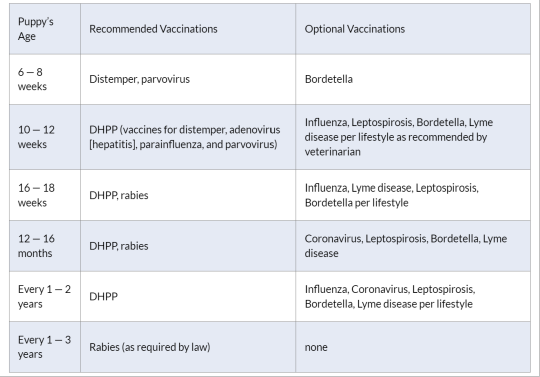
How Much Do Puppy Vaccinations Cost?
How much puppy vaccinations will cost depends on several factors. Where you live is a big one: Veterinarians in crowded and expensive urban areas will generally charge more than a rural vet in a small town. You may be able to find low-cost clinics providing rabies vaccinations sponsored by your local municipal government. But no matter what the range in costs, some vaccines, such as the “core vaccines” and rabies, are necessary.
The average cost can average around $75—100. These will include the core vaccines, which are administered in a series of three: at 6-, 12-, and 16 weeks old.
The core vaccines include the DHLPP (distemper, hepatitis, leptospirosis, parvo, and parainfluenza). Your pup will also need a rabies vaccination, which is usually around $15—20. (Some clinics include the cost of the rabies vaccination.)
Often animal shelters charge less for vaccines — approximately $20 — or are even free. If you acquired your dog from a shelter, he would most likely have been vaccinated, up until the age when you got him.
The initial puppy vaccination costs during the first year are higher than during adulthood.
Vaccinations for Adult Dogs: Boosters and Titers
There is a difference of opinion about having your adult dog vaccinated every year. Some vets believe too many vaccinations in adult dogs pose health risks. But others disagree, saying that yearly vaccinations will prevent dangerous diseases such as distemper. Talk with your vet to determine what kind of vaccination protocol works for you and your dog.
Many dog owners opt for titer tests before they administer annual vaccinations. Titer tests measure a dog’s immunity levels, and this can determine which, if any, vaccinations are necessary. One key exception to this is rabies: a titer test is not an option when it comes to the rabies vaccine. This vaccination is required by law across the United States. Your vet can tell you the schedule for your particular state, with boosters often lasting three years.
And it’s all worth it. For your effort and care your puppy will lavish you with lifelong love in return. This critical first year of her life is a fun and exciting time for both of you. As she grows physically, the wonderful bond between you will grow, too.
#puppy vacinations#puppy vaccines#puppy shots#puppy shots schedule#dog vaccinations#dog health#puppy health
5 notes
·
View notes
Text
Randomly fell on this paper while looking for pics of Yellowstone wolves for my current lesson and while I'm sad this is too complex for me to use in my current teaching level, this is awesome.
To summarize (badly, read the article if that's your thing), scientists have found that the virus causing canine distemper selects for more black wolves (who are more resistant to the disease) and that in populations where outbreaks are frequent, sexual selection has adapted for it and wolves tend to chose partners with a different coat colour more than in other populations.
This is so cool I love this.
3 notes
·
View notes
Note
Hello I very nearly blocked you and reported your blog as spam out of habit. Because yknow. The bot issue. But I am DELIGHTED to find out you're a real person so anyway
As you seem to be an expert, what is the best kind of wolf? I know very little about wolves but I assume there are different kinds as they show up in multiple countries. And also what is the coolest wolf fact you have locked and loaded?
HAHA i do the same thing when i see i have a new follower T_T these bots are unbearable....
there are many different species of wolves!!! but my favorite and the best (to me) is the gray wolf. The gray wolf is probably what most people think of when they think "wolf" and is located mostly in north america.
Ok my coolest wolf fact of late has to do with gray wolves coat color! For context gray wolves have two coat colors, black and gray, but originally gray wolves were only gray. it turns out that the black coat gene (called K Locus) actually comes from dogs!
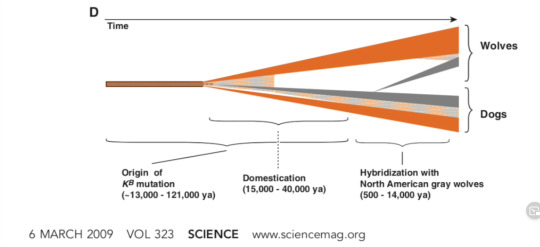
At some point wolves interbred with dogs which caused this mutation to appear in the wolf gene pool and black coats became common place with gray wolves. That's not the only cool thing about the black coat though, one of the reasons this gene was so successful is because wolves with black coats are more resistant to canine distemper virus! So where ever there's a population of gray wolves and they have a high number of black coated wolves, there has probably been a canine distemper outbreak

thank you very much for asking about wolves ^_^ !!!!!!!! Hope you thought this fact was neat
8 notes
·
View notes
Text
canine distemper looks a lot like rabies in wild animals (wild canids as well as raccoons, skunks, weasels, ferrets). it can be transmitted through direct contact with an afflicted creature or its secretions (urine, saliva, feces, sweat). its also very fatal, as it attacks the nervous system. its not known to transfer to humans or cats (though feline distemper is also a thing), but humans can spread it to their dogs if they have the virus on their hands/clothing and touch a dog or its environment. theres no real cure, but if youre able to treat it immediately a dog can recover (dependent on immune system, strain, etc). all this to say its very important to avoid coming into contact with these poor creatures and to call animal control if you see wild animals behaving oddly, and take precautions to protect yourself and your pets
Cartoons messed people up on what rabies looks like. Ppl think of a rabid animal and assume it's always snarling and frothing at the mouth and ready to attack. Rabid animals can appear really friendly because they lose human fear and they might approach you supposedly looking for food. It might look like a deer stumbling in circles and limping and falling over as if it's injured and disoriented. Might looks like a fox repeatedly trying and failing to stumble to its feet and unable to pick its head up. Their brains are melting. They might seem angry but they might also seem confused or injured or in need. But if you try to help that injured crying fox you could end up getting bit by an animal that's basically already dead and then your brain will melt too
#ive done a bit of research on distemper in raccoons so#all my info is stuff ive read from state and national wildlife sites the cdc and other government conservation resources#unfortunately when you call this stuff in for wild animals theyll have to euthenize them bc by the time youre seeing them behave weird#theyre too far gone
52K notes
·
View notes
Text
Bệnh care ở chó là một trong những bệnh truyền nhiễm nguy hiểm nhất, gây lo ngại cho cả người nuôi thú cưng và các chuyên gia thú y. Đây là bệnh do virus Canine Distemper Virus (CDV) gây ra, ảnh hưởng nghiêm trọng đến hệ miễn dịch của chó, đặc biệt là chó con. Trong bài viết này, Nhà Của Pet sẽ giúp bạn hiểu chi tiết về bệnh care ở chó, từ nguyên nhân, triệu chứng, cách phòng ngừa đến các giải pháp điều trị hiệu quả.
0 notes
Text
🐾 Common Canine Diseases: Parvo vs Distemper

🐕 Dog Health Basics: Knowing about Canine Parvovirus and Canine Distemper is a must for dog owners. These diseases are serious and very catching, especially for puppies. They cause different symptoms but both can be really bad.
🌀 Canine Parvovirus: Parvovirus is a bug that really messes with a dog's tummy. Sick dogs get lots of throw-up, bad diarrhea (sometimes with blood), and feel very tired. It can also hurt puppies' hearts and cause sudden death.
🐶 Canine Distemper: Distemper is a tricky virus that can hurt a dog's breathing, tummy, and brain. Symptoms are all over the place but often include a high fever, cough, snot, and brain problems like seizures or wobbliness.
🔍 Spotting the Difference:

🏥 Diagnosis: Finding out the right disease is super important. Your vet will check your dog, ask about their past, and maybe do tests like poop checks or blood tests.
🧪 Test Your Pup:
Quick Test Strips: Find these at pet places to spot Parvovirus fast.
PCR Test Kits: These are super sensitive and can find virus bits in your dog.
Immunofluorescence Testing: This shows virus bits directly.
🏷️ Top Brands for Tests:
IDEXX: Known for reliable pet health tests worldwide.
Zoetis: Another big name with good products.
Tashikin: A new brand with good stuff at a nice price.
💊 Treatment Time: Both Parvo and Distemper need quick care, but how we treat them is a bit different.
💧 Helping Out:
Hydrating: Giving dogs water and stuff to keep them from getting too dry.
Food: Giving easy-to-eat food or supplements.
Warmth: Keeping them cozy.
Antibiotics: Because these bugs love company with bacteria.
💡 Special Treatments:
Parvo: No special drugs, just supportive care.
Distemper: Might use antiviral drugs, but it's not sure yet.
🌟 Neuro Care:
Parvo: Doesn't cause brain stuff.
Distemper: Causes brain stuff, needs special care.
🛡️ Prevention Wins: The best way to stop these bugs? Vaccines! Puppies get a bunch of shots to keep them safe.
💉 Vaccine Brands:
MSD Animal Health: Makes good, solid vaccines.
Boehringer Ingelheim: Another company with a good vaccine line.
Merck Animal Health: Known for their great vaccines.
Conclusion: Parvo and Distemper are different but both are bad news. Knowing the differences helps you spot if your dog is sick and get them the right help.
Don't forget to share this post with your friends and fellow pet parents who would find this as fascinating as you do. Together, we can create a community that values and promotes the well-being of our furry companions.
0 notes
Text
Dog has tomato juice colored loose stools
If a dog has loose stools the color of tomato juice, it means that the dog has blood in the stool, indicating that the intestines have been damaged and bleeding, which may be caused by foreign body scratches, coccidia, infectious diseases and other factors. If it is caused by parvovirus or canine distemper virus infection, it is usually accompanied by symptoms such as depression and abnormal body…
0 notes
Text
The Canine Influenza Vaccine Market is projected to grow from USD 1,780.70 million in 2024 to USD 2,503.4 million by 2032, registering a compound annual growth rate (CAGR) of 4.35%. The canine influenza vaccine market has emerged as a vital segment of the broader veterinary pharmaceutical industry, driven by rising awareness among pet owners about the health risks associated with canine influenza and the increasing prevalence of this contagious respiratory disease. Canine influenza, or dog flu, is caused by the H3N8 and H3N2 strains of the influenza virus, and while it is not typically fatal, it can lead to severe respiratory illness in dogs, especially in those with compromised immune systems. The rising demand for canine influenza vaccines, in response to growing outbreaks and increasing pet adoption rates, is shaping the market dynamics. This article explores the key trends, drivers, challenges, and future outlook for the canine influenza vaccine market.
Browse the full report at https://www.credenceresearch.com/report/canine-influenza-vaccine-market
Market Overview
The global canine influenza vaccine market has been growing steadily over the past few years, with projections indicating substantial growth in the coming decade. The market is driven by factors such as increasing pet ownership, the rising awareness of pet healthcare, the growing number of veterinary clinics, and the increased focus on preventive healthcare for animals. The demand for vaccines has been bolstered by an increasing number of dog flu outbreaks across various regions, particularly in North America, which has one of the largest dog populations in the world.
Canine influenza vaccines are typically administered as part of a comprehensive pet vaccination program, which also includes rabies, distemper, and other critical vaccines. Several pharmaceutical companies, including Zoetis and Merck Animal Health, are leading players in this market, offering vaccines for both the H3N8 and H3N2 strains.
Key Market Drivers
1. Rising Pet Ownership and Humanization of Pets: The increasing trend of pet ownership, especially dogs, is a major factor driving the canine influenza vaccine market. Pet owners are increasingly treating their pets as family members and are more willing to invest in their pets' health and well-being. This trend, known as the "humanization of pets," has led to greater demand for high-quality veterinary services and preventive healthcare products, including vaccines.
2. Awareness of Canine Influenza and Vaccination Benefits: There has been a significant increase in awareness about canine influenza among pet owners and veterinarians. Awareness campaigns by veterinary organizations and pharmaceutical companies have highlighted the importance of vaccination in preventing the spread of dog flu. In areas where outbreaks have occurred, vaccination rates have surged as pet owners seek to protect their pets from potential exposure.
3. Increasing Outbreaks and Geographic Spread: Over the last decade, canine influenza outbreaks have been reported in several regions across the world. While the disease was initially limited to certain areas, it has since spread to new geographies, leading to heightened concern among dog owners. In particular, outbreaks in densely populated urban areas and regions with high dog ownership rates have fueled demand for vaccines.
4. Expansion of Veterinary Healthcare Infrastructure: The growing number of veterinary clinics, hospitals, and pet healthcare centers is also contributing to the rising demand for canine influenza vaccines. As more pet owners have access to veterinary services, the vaccination rates are expected to rise. Additionally, mobile veterinary services and vaccine clinics have made it easier for pet owners to vaccinate their pets.
Market Challenges
Despite the positive growth outlook, the canine influenza vaccine market faces several challenges:
1. Vaccine Hesitancy Among Pet Owners: Some pet owners are hesitant to vaccinate their dogs due to concerns about vaccine safety or the belief that their pets are not at risk of contracting the disease. Overcoming this hesitancy requires educational efforts by veterinarians and pharmaceutical companies to emphasize the benefits and safety of vaccination.
2. Cost of Vaccination: For some pet owners, the cost of vaccinating their dogs may be a barrier. While the vaccine is relatively affordable, pet owners with multiple animals or those on a tight budget may find it challenging to cover the cost of regular vaccinations, including those for canine influenza.
3. Limited Awareness in Developing Regions: In many developing regions, awareness about canine influenza and the availability of vaccines is still limited. Veterinary infrastructure may also be underdeveloped in these areas, making it difficult for pet owners to access vaccines. Addressing these gaps will be crucial for market expansion in emerging markets.
Future Outlook and Opportunities
The canine influenza vaccine market is expected to witness continued growth in the coming years, with several opportunities for expansion. The development of more effective vaccines, including combination vaccines that protect against multiple strains, could drive demand. Additionally, increasing awareness campaigns and partnerships between pharmaceutical companies and veterinary organizations will help boost vaccination rates.
Technological advancements in vaccine development, such as the use of novel adjuvants and delivery systems, could also enhance vaccine efficacy and improve pet owner compliance. Furthermore, as the trend of pet adoption continues to rise globally, particularly in emerging markets, the potential for market growth remains strong.
Key Player Analysis:
Zoetis Inc.
Merck Animal Health
Boehringer Ingelheim
Elanco Animal Health
Virbac
Ceva Santé Animale
Merial (Sanofi)
Phibro Animal Health Corporation
Vetoquinol
Heska Corporation
Segmentations:
By Vaccine Type:
Recombinant Vaccines
Inactivated Vaccines
Others
By Virus Type:
H3N8 virus
H3N2 virus
By Distribution Channel:
Public
Private
By Region:
North America
U.S.
Canada
Mexico
Europe
Germany
France
U.K.
Italy
Spain
Rest of Europe
Asia Pacific
China
Japan
India
South Korea
South-east Asia
Rest of Asia Pacific
Latin America
Brazil
Argentina
Rest of Latin America
Middle East & Africa
GCC Countries
South Africa
Rest of the Middle East and Africa
Browse the full report at https://www.credenceresearch.com/report/canine-influenza-vaccine-market
About Us:
Credence Research is committed to employee well-being and productivity. Following the COVID-19 pandemic, we have implemented a permanent work-from-home policy for all employees.
Contact:
Credence Research
Please contact us at +91 6232 49 3207
Email: [email protected]
Website: www.credenceresearch.com
0 notes
Text
Let me tell you the story of one of the oldest dog burials that we can be sure is an actual dog that lived with people.
This dog was buried. We know that for sure. But what they also found was that this dog was suffering from the extreme late stages of canine distemper. For those that don’t know, distemper is a virus that causes severe neurological degeneration eventually leading to death. This dog had been in the last stages of the disease. It would have been unable to walk, unable to do anything but twitch.
Most wolves never get to that stage. Most of them are killed long before when they loose the ability to walk and hunt.
The only way for this animal to have survived that long, was that it had someone caring for it. That someone loved this dog enough to keep feeding it and looking after it longer after it had lost to the ability to do anything but lie on the ground and shake. And after it inevitably died, they buried it.
We’ll never know the whole story of course. But whatever their motivations, someone obviously cared enough to look after this animal long after it had lost all utility it might have had. Maybe it was out of a sense of moral obligation, maybe they hoped it would get better, or maybe they were just trying to make its last days as comfortable as they possibly could.
Do you think stone age people held funerals for their dogs? They buried their dead, that we know. Some were buried with their dogs, so wherever their dead would go, with their bows and arrows and bone flutes, clearly they figured that it's better for the dogs to follow to wherever the departed will go. But people outlive their dogs more often than dogs outlive their people. Did they figure that whatever is beyond, dogs go to the same place that people do?
Before stone houses, cattle, barley or rice, before people came up with the marks that the people now like to call marks of "civilisation", they had stone axes, bone spears and dogs. No other animal would willingly climb to a human's bed to sleep on their feet, or rest their chin on your knee to look you in the eyes while begging for food when they've already been fed. Did they laugh when a dog was clever enough to wriggle its way out of a tethered leash to get into venison that was being smoked for winter, or wake their people up by the tap of a wagging tail after reluctantly accepting that they aren't allowed to bark them awake?
Did they ever pause in the middle of a story at the fire at night, to turn and watch one of the dogs mutter barks and twitch paws in their sleep? Whatever they thought that dreams were, they knew dogs have them too. Did they wonder what dogs dream of? Visions of past and future hunts? If they thought that dreams were another realm, where your soul will sometimes visit while leaving your body behind, where does the soul of a dog go?
Did they wonder where the souls of dogs go?
1K notes
·
View notes
Photo

A comprehensive guide to understanding distemper, its causes, symptoms, treatment options, and preventive measures, with a focus on the importance of vaccination. read the full article: https://bit.ly/4ddcEVP #distemper #canine #virus #pet #health #vaccination #disease read more: what is distemper
0 notes
Note
I saw some wolf dogs that look a bit like you!
https://brindleberryacres.com/yamnuska-wolfdog-sanctuary/
was surprised since all the photos I���ve seen of black wolves with reddish/brown undertones like you have been 100% wolf! Although, these guys are pretty high content. ALTHOUGH ALTHOUGH, the gene for black fur in wolves, common in yellow stone nation park (where my wolf self belongs too!) and rarer outside of it, is believed to have comes from ancient mixing with domestic dog populations. its a dominant gene - KK, or Kk. I love simple genetics it makes my brain whirr. It also gives them resistance to canine distemper virus! because of that grey coloured (kk) wolves have a mate preference for it. so by wolf rules, you’re objectively attractive lmao.despite their resistance to canine distemper, homozygous double K locus wolves - KK - don’t often fare well in life compared to Kk or kk counterparts. (kk means they will be grey - like me)
Wolves with any black K locus mutation also have different behaviour, being less aggressive . But culturally black wolves in Tibet are consider bolder and more aggressive.
In historical European accounts, black wolves are also larger than grey counterparts. Others say they were the same size but stronger. I could go on, but I need to do the things for the day. Buh-bye!
- 🧂
Woah, that first one Zeus is actually what I look like omg! Thank you so much, that’s so cool!! And ooo omg I love being objectively attractive in wolf rules lol. And I had no idea about all of that stuff, thank you for telling me! I could listen to you ramble on forever :)
1 note
·
View note
Text
Tuscaloosa shelter closes adoptions amid canine distemper outbreak
New Post has been published on https://petn.ws/ibCW0
Tuscaloosa shelter closes adoptions amid canine distemper outbreak
Monica Nakashima and Tim Reid 41 mins ago TUSCALOOSA, Ala. (WIAT) — Tuscaloosa Metro Animal Shelter announced a public health notice that will halt adoptions for the next two weeks. Two confirmed cases of canine distemper have been diagnosed within the shelter. To contain the spread of the virus, the shelter will be closing adoptions and […]
See full article at https://petn.ws/ibCW0 #DogNews
0 notes
Text
Deadly Virus Causes Racoons to Act Like 'Zombies' In Canada -Read more at https://gazettereview.com/deadly-virus-causes-racoons-to-act-like-zombies-in-canada/ - https://gazettereview.com/wp-content/uploads/2024/05/zombie-raccoons.jpg #World
Deadly Virus Causes Racoons to Act Like 'Zombies' In Canada
Officials are advising Toronto residents to avoid raccoons, whether they look healthy, sick, or injured, due to a ‘zombie’ virus outbreak that is spreading rampantly throughout the species. The ‘zombie’ virus, also known as canine distemper virus (CDV) is a viral disease that affects mammals, including dogs, skunks, foxes, and raccoons. Once an animal becomes […]
https://gazettereview.com/deadly-virus-causes-racoons-to-act-like-zombies-in-canada/
0 notes
Text
Protecting Your Canine Companion: A Guide to Vaccinations for Dogs in Abbotsford

As responsible pet owners, ensuring the health and well-being of our furry friends is paramount. One of the most crucial aspects of pet healthcare is vaccinations. In Abbotsford, where the bond between humans and their canine companions is strong, understanding the importance of vaccinations is vital. At Glenn Mountain Animal Hospital, we prioritize the health and happiness of your pets, offering comprehensive vaccination services to keep them protected from preventable diseases.
Vaccinations are essential for safeguarding dogs against a range of potentially life-threatening illnesses. In Abbotsford, where pets often enjoy an active outdoor lifestyle, the risk of exposure to infectious diseases is higher. By staying up to date with vaccinations, pet owners can help prevent the spread of diseases and protect their beloved companions.
One of the primary vaccines recommended for dogs is the rabies vaccine. Rabies is a fatal viral disease that can be transmitted to humans through the bite of an infected animal. In Abbotsford, where wildlife encounters are common, ensuring dogs are vaccinated against rabies is not only a legal requirement but also a crucial step in preventing the spread of this deadly virus.
Another important vaccination is the distemper vaccine, which protects against canine distemper virus—a highly contagious and often fatal disease that affects the respiratory, gastrointestinal, and nervous systems of dogs. By vaccinating against distemper, pet owners can shield their dogs from this serious illness, which is particularly prevalent in areas with dense dog populations like Abbotsford.
Parvovirus is another significant threat to dogs, especially puppies and unvaccinated adults. This highly contagious virus attacks the gastrointestinal tract, causing severe vomiting, diarrhea, dehydration, and in severe cases, death. Vaccination against parvovirus is crucial for puppies in Abbotsford, where the virus can lurk in the environment and spread rapidly among susceptible dogs.
At Glenn Mountain Animal Hospital, we offer a range of core and non-core vaccinations tailored to meet the specific needs of each dog. Our experienced veterinarians will assess your pet's lifestyle, risk factors, and medical history to create a personalized vaccination plan that provides optimal protection.
In addition to vaccinations, regular wellness exams are essential for maintaining your dog's health. During these exams, our veterinarians can assess your pet's overall health, discuss any concerns you may have, and ensure that vaccinations are kept up to date. By staying proactive about your dog's healthcare, you can help them live a long, happy, and healthy life.
As the leading vet hospital Abbotsford, Glenn Mountain Animal Hospital is committed to providing exceptional care for your pets. Our state-of-the-art facility, experienced team, and compassionate approach set us apart as a trusted partner in your pet's health journey.
Whether you’re Vaccinations for Dogs in Abbotsford, wellness exams, or emergency care, you can count on Glenn Mountain Animal Hospital to deliver top-quality veterinary services with a personalized touch. Contact us today to schedule an appointment and give your canine companion the protection they deserve.
Protect your dog and give them the gift of good health—schedule a vaccination appointment at Glenn Mountain Animal Hospital today.
0 notes